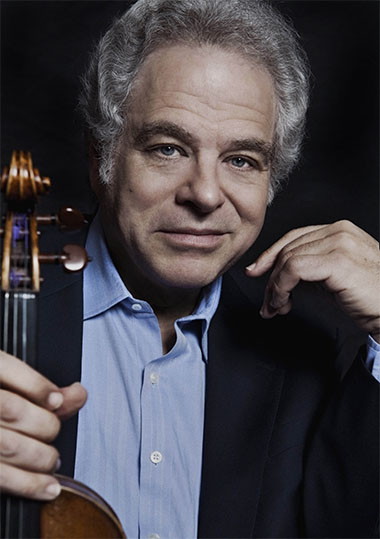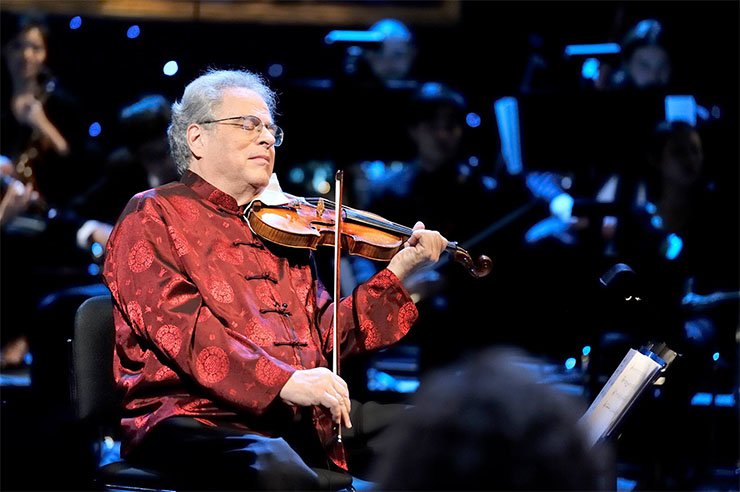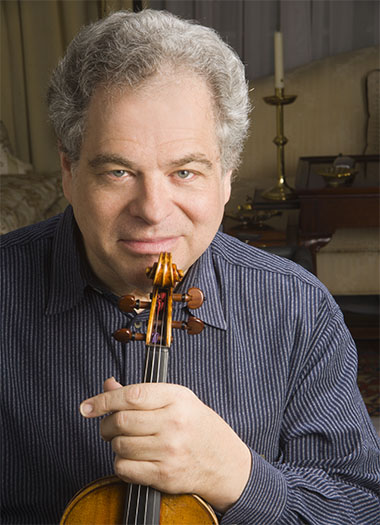
People often have a common knee-jerk reaction to a person with a disability; they immediately think the blind person or person in the wheelchair in front of them is completely disabled. Of course, once you learn that the guy has kids, grocery shops or plays the violin, perception suddenly shifts, and the conversation begins to focus on ability and a whole person emerges from behind the white cane.
Prime example: When Itzhak Perlman takes the stage on his electric scooter, the audience doesn’t see the man who can’t walk, but a dazzling violinist and raconteur.
Over the years, Miami audiences have heard Perlman, a musician honored with 16 Grammy Awards and four Emmys, perform with Emanuel Ax, Vladimir Horowitz, Yo-Yo Ma, and most recently with the Klezmer Conservatory Band, raising the roof at the Knight, celebrating the 20th anniversary of Perlman’s album and Emmy-winning PBS special, “In the Fiddler’s House.”
On Thursday, March 7, Itzhak Perlman and Rohan De Silva appeared in a two-hander at the Knight Concert Hall for the final program of the 2018-19 Knight Masterworks Classical Music Series, that previously included the Orpheus Chamber Orchestra, Israel Philharmonic Orchestra, Academy of St Martin in the Fields, Chicago Symphony orchestra, and now Itzhak Perlman’s long-awaited recital.
Sri Lankan pianist De Silva, elegant in appearance and at his keyboard, was a masterful compliment to Perlman; they were not unlike characters in a two-hander play with snappy dialogue, who argue, listen, react, as the tempo keeps shifting, one landing a point, then the other landing one, one dominating, one submitting, reversing their roles, and finally resolving their issue.
When you pair Perlman, who first took the world stage on the "Ed Sullivan Show" at age 13, and has since played with every top-shelf musician and orchestra since, with De Silva, who studied at the Royal Academy of Music and the Juilliard School and has performed in venues worldwide, words fall short and notes rain down like Niagara Falls.
Upon taking the stage to a standing ovation by a packed house, Perlman and De Silva eased into Alfred Schnittke’s Suite in the Old Style for Violin & Piano.
The polystylistic Soviet and German contemporary composer Schnittke often wrote in many styles over many musical genres. The suite was a pastiche of his works, including a theme from a Soviet cartoon (“Pastorale”), a figure from a short movie about a dentist (“Baletto”), “Minuetto” and “Fuga” with a modern Baroque flare, and the dance that is impossible to resist (“Pantomima”).

Perlman’s violin was all at once subtle, sweet and precise, De Silva’s hands running non-stop, as violin and piano tracked each other exactly, calling and answering one another with the pleasant melodies of the first two movements. The minuet, tender and lovely, plunged into the fugue, De Silva taking the lead and background seamlessly, his hands as two distinct voices with the counterpoint, while Perlman acquitted the melody with assurance. Featuring the violin, the beautiful theme of the “Pantomima” was a tug-at-the-heartstrings moment in the emotional hands of Perlman.
A two-hander play has been described as "...like a Porsche. It's sleek, it does exactly what you want it to do, and it can speed up but also shows off great brakes." This characterization aptly applies to Beethoven’s Sonata for Violin and Piano No. 9 (aka "Kreutzer Sonata"), displaying emotional depth and technical prowess, Perlman and De Silva paying fierce attention to both aspects.
A presto emerged from the quiet beginning, stops and starts presenting as precise as a blade. De Silva’s transitions from soft to loud were fluid, the pair’s timing was that of a Swiss watch throughout the first movement and into its furious coda.
Perlman introduced the motif for the variations, about to unfold in the second movement, with dynamic flare, a single line of the figure developing with tiny bursts of volume transitioning into a peppy variation with the piano front and center, punctuated by the violin. Perlman reached for and softly landed in the attic, a variation grew dark and the pair emerged trilling with the melody, the piano sounding like a tinkling music box.

In the third, the duo shot out of the gate at breakneck speed with a high-spirited tarantella, the pair enjoying the competition, dramatically pacing each other over the finish line. Perlman, always with a genial expression, was fully focused on the work, investing all his energy into the playing.
Dvorák geared his Sonatina in G major for Violin and Piano towards the developing musical abilities of his children. Not unlike most of his works composed during his time spent in America, the four short movements of the sonatina were fueled with themes inspired by Native American melodies and Afro-American spirituals.
The conversation continued between Perlman and De Silva with the tight and lively first movement, Perlman pulling all the emotion out of the lament of the second, then returning to a joyous place with piano in tow, the violin stating the lovely and upbeat motif of the third, the piano and violin now functioning as one organ. A frisky melody blending with a spiritual figure turned back into a scamper and the piece finished with the assurance of two great artists who take great pleasure in their work.
Perlman scooted offstage and returned with a stack of papers and reported to the audience that he was holding a computer readout of everything he’s played since 1911 (he was born in 1945); it was source material for a few encores.
He diligently rifled through the stack and settled on a piece by the Austrian-born violinist Fritz Kreisler, luxuriating with “Praeludium and Allegro in the Style of Pugnani,” nimbly navigating lines cascading downward and then high-flying into double and triple stops.
The main theme from “Schindler's List,” composed by John Williams, originally performed by Perlman for the film, was the next encore. The anguish inherent in the score was rendered, perhaps, as only a Jewish virtuoso could present it, Perlman wringing every note of melancholy out of the piece, the resulting texture fluid and heartfelt.
Perusing his stack for his final encore, he settled on Brahms Hungarian Dance No. 1. For 3 minutes, Perlman travelled great distances up and down the neck of his violin, his ascents straight up to the top, unblemished and thrilling. A crowd pleaser.
 MAIN MENU
MAIN MENU

